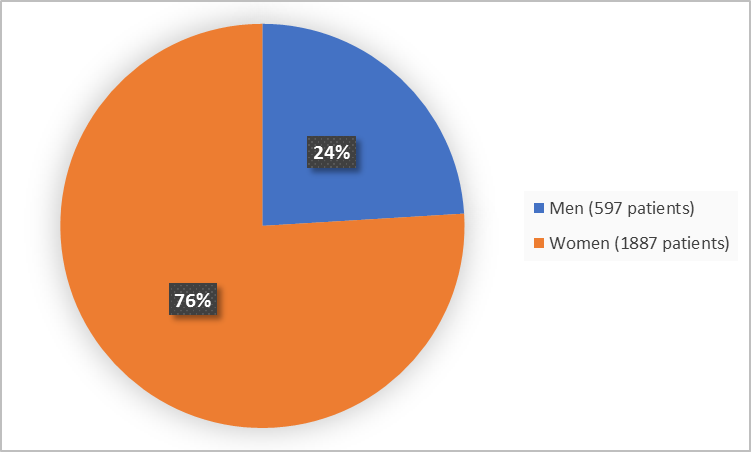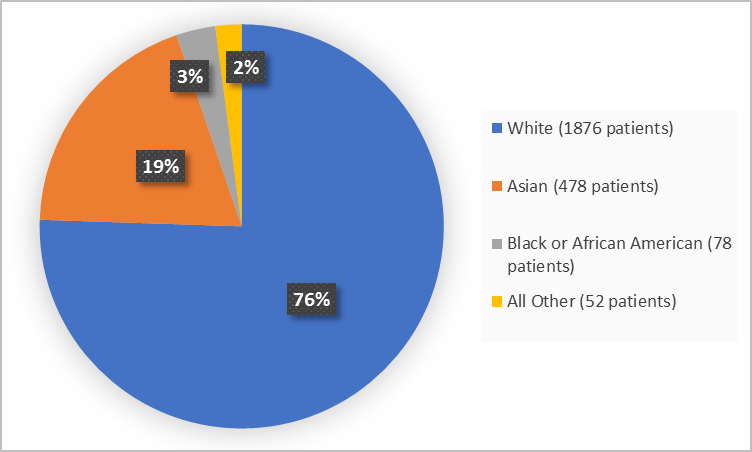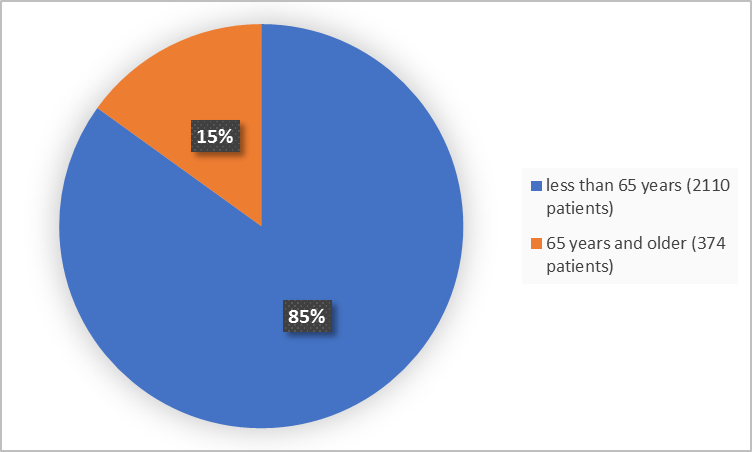Drug Trials Snapshots: MOTEGRITY
HOW TO USE THIS SNAPSHOT
The information provided in Snapshots highlights who participated in the clinical trials that supported the FDA approval of this drug, and whether there were differences among sex, race, and age groups. The “MORE INFO” bar shows more detailed, technical content for each section. The Snapshot is intended as one tool for consumers to use when discussing the risks and benefits of the drugs.
LIMITATIONS OF THIS SNAPSHOT:
Do not rely on Snapshots to make decisions regarding medical care. Always speak to your health provider about the risks and benefits of a drug. Refer to MOTEGRITY Prescribing Information for complete information.
MOTEGRITY (prucalopride)
moe-teh'-gri-tee
Shire
Approval date: December 14, 2018
DRUG TRIALS SNAPSHOT SUMMARY:
What is the drug for?
MOTEGRITY is used to treat adults with a type of constipation called chronic idiopathic constipation (CIC).
“Idiopathic” means that the cause of the constipation is unknown.
How is this drug used?
MOTEGRITY is a tablet taken one time each day.
What are the benefits of this drug?
More patients who received MOTEGRITY experienced an increase in the number of complete spontaneous bowel movements (CSBMs) to at least 3 bowel movements per week than those who received placebo.
What are the benefits of this drug (results of trials used to assess efficacy)?
Patients who entered the trial had a history of chronic constipation which included having less than 3 bowel movements per week. Efficacy was assessed using information provided by patients on a daily basis in an electronic diary. A responder was defined as a patient with an average of 3 CSBMs per week over the 12-week treatment period.
The table below summarizes efficacy results for the clinical trials based on the primary efficacy endpoint.
Table 2. Efficacy Responder Rates in Placebo Controlled Studies of CIC: Proportion of Patients with an Average Weekly Frequency of ≥3 CSBMs per Week over 12 Weeks of Treatment (ITT Population)
| Trial | MOTEGRITY 1 or 2 mg Once Daily | Placebo | Treatment Difference (95% CI) |
p value | ||
|---|---|---|---|---|---|---|
| N | n (%) | N | n (%) | |||
| Trial 1 | 249 | 83 (33) | 252 | 26 (10) | 23 (16, 30) |
p<0.001 |
| Trial 2 | 177 | 67 (38) | 181 | 32 (18) | 20 (11, 29) |
p<0.001 |
| Trial 3 | 236 | 46 (19) | 240 | 23 (10) | 10 (4, 16) |
p=0.002 |
| Trial 4 | 190 | 55 (29) | 193 | 25 (13) | 16 (8, 24) |
p<0.001 |
| Trial 5 | 214 | 50 (24) | 212 | 25 (12) | 12 (4, 19) |
p<0.001 |
| Trial 6 | 171 | 43 (25) | 169 | 34 (20) | 5 (-4, 14) |
p=0.341 |
N = number of patients per treatment group
n = number of responders
CI=confidence interval
p-value based on a Cochran-Mantel-Haenszel test
MOTEGRITY Prescribing Information
Were there any differences in how well the drug worked in clinical trials among sex, race and age?
- Sex: MOTEGRITY worked similarly in men and women.
- Race: MOTEGRITY worked similarly in White and Asian patients. The number of patients in other races was limited; therefore, differences in response among all races could not be determined.
- Age: MOTEGRITY worked similarly in patients younger than 65 years and 65 years or older.
Were there any differences in how well the drug worked in clinical trials among sex, race, and age groups?
Tables below summarize efficacy results by sex, race and age subgroup for each trial that includes patients who received 2 mg of MOTEGRITY or placebo daily (ITT population).
Table 3. Results for the Primary Efficacy Endpoint by Sex (ITT population)
| Trials | Men | Women | ||||
|---|---|---|---|---|---|---|
| MOTEGRITY n/N (%) |
Placebo n/N (%) |
Difference (95% CI) |
MOTEGRITY n/N (%) |
Placebo n/N (%) |
Difference (95% CI) |
|
| Trial 1 | 6/22 (27) | 2/29 (7) | 20 (0, 41) | 77/227 (34) | 24/223 (11) | 23 (16,31) |
| Trial 2 | 67/177 (38) | 32/181 (18) | 20(11,29) | NA | NA | NA |
| Trial 3 | 3/25 (12) | 2/18 (11) | 0.9 (-18,20) | 43/211 (20) | 21/222 (10) | 11 (4,18) |
| Trial 4 | 3/16 (19) | 4/24 (17) | 2 (-22,26) | 52/174 (30) | 21/169 (12) | 17 (9,26) |
| Trial 5 | 7/33 (21) | 5/23 (22) | -0.5 (-22,21) | 43/181 (24) | 20/189 (11) | 13 (6,21) |
| Trial 6 | 8/24 (33) | 5/25 (20) | 13 (-11,38) | 35/147 (24) | 29/144 (20) | 4 (-6,13) |
NA=not applicable
Clinical Trial Data
Table 4. Results for the Primary Efficacy Endpoint by Race (ITT population)
| Trials | White | All Other | ||||
|---|---|---|---|---|---|---|
| MOTEGRITY n/N (%) |
Placebo n/N (%) |
Difference (95% CI) |
MOTEGRITY n/N (%) |
Placebo n/N (%) |
Difference (95% CI) |
|
| Trial 1 | NA | NA | NA | 83/249 (33) | 26/252 (10) | 23 (16,30) |
| Trial 2 | 67/177 (38) | 32/181 (18) | 20 (11,29) | NA | NA | NA |
| Trial 3 | 45/221 (20) | 22/226 (10) | 11 (4,17) | 1/15 (7) | 1/14 (7) | -1 (-19,18) |
| Trial 4 | 53/171 (31) | 22/166 (13) | 18 (9,26) | 2/19 (11) | 3/27 (11) | -1 (-19,18) |
| Trial 5 | 43/183 (24) | 25/197 (13) | 11 (3,19) | 7/31 (23) | 0/15 (0) | 23 (8,37) |
| Trial 6 | 41/158 (26) | 32/158 (20) | 6 (-4,15) | 2/13 (15) | 2/11 (18) | -3 (-33,27) |
NA=not applicable
Clinical Trial Data
Table 5. Results for the Primary Efficacy Endpoint by Age (ITT population)
| Trials | Age <65 years | Age ≥65 years | ||||
|---|---|---|---|---|---|---|
| MOTEGRITY n/N (%) |
Placebo n/N (%) |
Difference (95% CI) |
MOTEGRITY n/N (%) |
Placebo n/N (%) |
Difference (95% CI) |
|
| Trial 1 | 83/249 (33) | 26/252 (10) | 23 (16,30) | NA | NA | NA |
| Trial 2 | 39/98 (40) | 16/110 (15) | 25 (14,37) | 28/79 (35) | 16/71 (23) | 13 (-1,27) |
| Trial 3 | 40/209 (19) | 20/216 (9) | 10 (3,17) | 6/27 (22) | 3/24 (13) | 10 (-11,30) |
| Trial 4 | 49/165 (30) | 20/165 (12) | 18 (9,26) | 6/25 (24) | 5/28 (18) | 6 (-16,29) |
| Trial 5 | 42/180 (23) | 23/189 (12) | 11 (3,19) | 8/34 (24) | 2/23 (9) | 15 (-3,33) |
| Trial 6 | 36/141 (26) | 30/138 (22) | 4 (-6,14) | 7/30 (23) | 4/31 (13) | 10 (-1,30) |
NA=not applicable
Clinical Trial Data
What are the possible side effects?
MOTEGRITY may cause suicidal thoughts and behavior.
The most common side effects of MOTEGRITY are headache, stomach pain, nausea, diarrhea, stomach distention, dizziness, vomiting, gassiness, and fatigue.
What are the possible side effects?
The table below summarizes adverse reactions that occurred in combined six clinical trials.
Table 6: Common Adverse Reactions* in Six Double-Blind Placebo-Controlled Trials of CIC of at least 12 Weeks Duration
| Adverse Reaction | MOTEGRITY 2 mg N=1251† % |
Placebo N=1279 % |
|---|---|---|
| Headache | 19 | 9 |
| Abdominal pain‡ | 16 | 11 |
| Nausea | 14 | 7 |
| Diarrhea | 13 | 5 |
| Abdominal distension | 5 | 4 |
| Dizziness | 4 | 2 |
| Vomiting | 3 | 2 |
| Flatulence | 3 | 2 |
| Fatigue | 2 | 1 |
*Reported in ≥2% of patients receiving MOTEGRITY and a rate higher than patients receiving placebo.
†Includes 93 patients who started on MOTEGRITY 1 mg and increased to MOTEGRITY 2 mg.
ǂ Includes abdominal pain, upper abdominal pain, lower abdominal pain, abdominal tenderness, abdominal discomfort, and epigastric discomfort.
MOTEGRITY Prescribing Information
Were there any differences in side effects among sex, race and age?
- Sex: The occurrence of side effects was similar in men and women.
- Race: The occurrence of side effects was similar in White and Asian patients. The number of patients in other races was limited; therefore, differences in side effects among all races could not be determined.
- Age: The occurrence of side effects was similar between patients younger than 65 years and 65 years or older.
Were there any differences in side effects of the clinical trials among sex, race, and age groups?
The table below summarizes subgroups of patients who reported any adverse event during clinical trials.
Table 7. Subgroup Analysis of Treatment Emergent AEs - (ITT population)
| Any TEAE | MOTEGRITY 2 mg (N=1237) |
Placebo (N=1247) |
|---|---|---|
| Overall, n (%) | 782 (59) | 668 (54) |
| Sex, n (%) | ||
| Men | 140 (47) | 116 (37) |
| Women | 642 (69) | 552 (58) |
| Race, n (%) | ||
| White | 596 (64) | 539 (57) |
| Asian | 135 (56) | 85 (36) |
| Black or African American | 29 (63) | 20 (63) |
| Age, n (%) | ||
| <65 years | 680 (65) | 578 (54) |
| ≥65 years | 102 (52) | 90 (51) |
Clinical Trial Data
WHO WAS IN THE CLINICAL TRIALS?
Who participated in the clinical trials?
The FDA approved MOTEGRITY based on evidence from six clinical trials of 2484 patients with CIC. The trials were conducted at 286 sites in the USA, Canada, Asia, Europe and Australia.
The figure below summarizes how many men and women were in the clinical trials.
Figure 1. Baseline Demographics by Sex
Clinical Trial Data
Figure 2 and Table 1 below summarize the percentage of patients by race in the clinical trials.
Figure 2. Baseline Demographics by Race
Clinical Trial Data
Table 1. Baseline Demographics by Race
| Race | Number of Patients | Percentage |
|---|---|---|
| White | 1876 | 76 |
| Black or African American | 78 | 3 |
| Asian | 478 | 19 |
| Other | 34 | 1 |
| Missing | 18 | 1 |
Clinical Trial Data
Figure 3 summarizes the percentage of patients by age enrolled in the clinical trials.
Figure 3. Baseline Demographics by Age
Clinical Trial Data
Who participated in the trials?
The table below summarizes demographics of patients in the clinical trials.
Table 8. Baseline Demographics of Participants in the Clinical Trials (ITT population)
| Subgroup | MOTEGRITY 2 mg N=1237 |
Placebo N=1247 |
TOTAL (N=2484) |
|---|---|---|---|
| Sex, n (%) | |||
| Men | 297 (24) | 300 (24) | 597 (24) |
| Women | 940 (76) | 947 (76) | 1887 (76) |
| Race, n (%) | |||
| White | 925 (75) | 951 (76) | 1876 (76) |
| Asian | 241 (19) | 237 (19) | 478 (19) |
| Black or African American | 46 (4) | 32 (3) | 78 (3) |
| Other | 16 (1) | 18 (1) | 34 (1) |
| Missing | 9 (1) | 9 (1) | 18 (1) |
| Age Group, n (%) | |||
| <65 years | 1041 (84) | 1069 (86) | 2110 (85) |
| ≥65 years | 196 (16) | 178 (14) | 374 (15) |
| Ethnicity, n (%) | |||
| Incomplete * | |||
| Geographic Region | |||
| US | 404 (33) | 405 (33) | 809 (33) |
| All Other | 833 (67) | 842 (67) | 1675 (67) |
* because of local regulations and old data
Clinical Trial Data
How were the trials designed?
The benefit and side effects of MOTEGRITY were evaluated in six clinical trials (Trial 1/ NCT01116206, Trial 2/ NCT01147926, Trial 3/ NCT00488137, Trial 4/ NCT00483886, Trial 5/ NCT00485940 and Trial 6/ NCT01424228) of 2484 patients with CIC. In all the six trials, patients received treatment with either MOTEGRITY or placebo once daily for at least 12 weeks. Neither the patients nor the health care providers knew which treatment was being given until after the trials were completed.
Based on the information from their electronic diaries, patients were evaluated for improvement in CSBMs over 12 weeks of treatment.
How were the trials designed?
The efficacy and safety of MOTEGRITY for the management of symptoms of CIC was established in six double blind, placebo-controlled, randomized, multicenter clinical trials of at least 12-week duration. Adult patients, 18-95 years old, had to have less than 3 spontaneous bowel movements (SBMs) per week specific constipation symptoms for at least 3 months prior to the screening visit, with symptom onset for at least 6 months prior to screening.
A responder was defined as a patient with an average of 3 CSBMs per week over the 12-week treatment period.
GLOSSARY
CLINICAL TRIAL: Voluntary research studies conducted in people and designed to answer specific questions about the safety or effectiveness of drugs, vaccines, other therapies, or new ways of using existing treatments.
COMPARATOR: A previously available treatment or placebo used in clinical trials that is compared to the actual drug being tested.
EFFICACY: How well the drug achieves the desired response when it is taken as described in a controlled clinical setting, such as during a clinical trial.
PLACEBO: An inactive substance or “sugar pill” that looks the same as, and is given the same way as, an active drug or treatment being tested. The effects of the active drug or treatment are compared to the effects of the placebo.
SUBGROUP: A subset of the population studied in a clinical trial. Demographic subsets include sex, race, and age groups.



